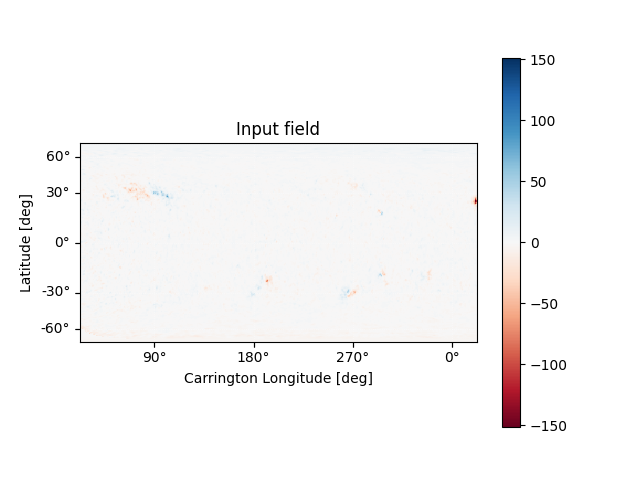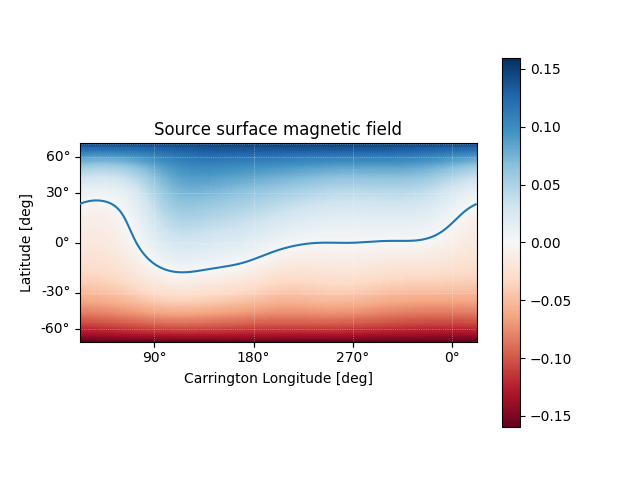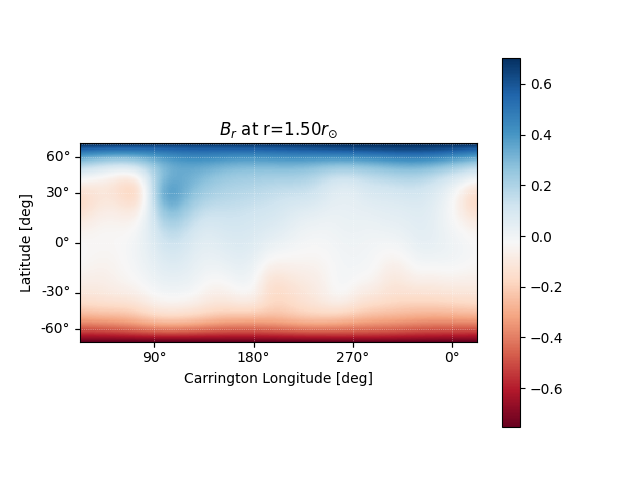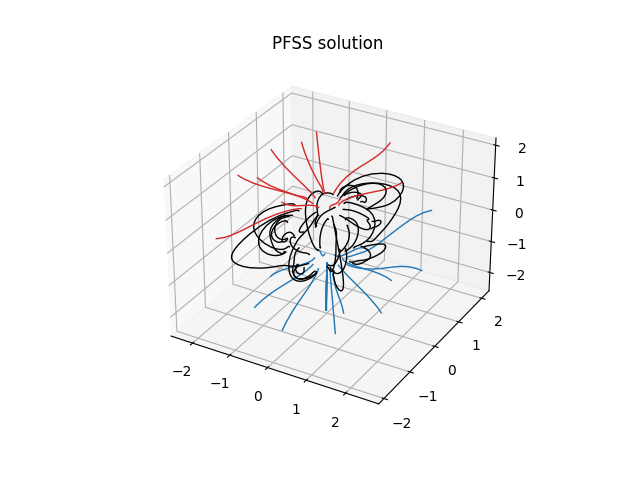Note
Click here to download the full example code
GONG PFSS extrapolation¶
Calculating PFSS solution for a GONG synoptic magnetic field map.
First, import required modules
import astropy.constants as const
import astropy.units as u
from astropy.coordinates import SkyCoord
import matplotlib.pyplot as plt
from mpl_toolkits.mplot3d import Axes3D
import numpy as np
import sunpy.map
import pfsspy
from pfsspy import coords
from pfsspy import tracing
from pfsspy.sample_data import get_gong_map
Load a GONG magnetic field map. If ‘gong.fits’ is present in the current directory, just use that, otherwise download a sample GONG map.
gong_fname = get_gong_map()
We can now use SunPy to load the GONG fits file, and extract the magnetic field data.
The mean is subtracted to enforce div(B) = 0 on the solar surface: n.b. it is not obvious this is the correct way to do this, so use the following lines at your own risk!
gong_map = sunpy.map.Map(gong_fname)
# Remove the mean
gong_map = sunpy.map.Map(gong_map.data - np.mean(gong_map.data), gong_map.meta)
The PFSS solution is calculated on a regular 3D grid in (phi, s, rho), where rho = ln(r), and r is the standard spherical radial coordinate. We need to define the number of rho grid points, and the source surface radius.
nrho = 35
rss = 2.5
From the boundary condition, number of radial grid points, and source surface, we now construct an Input object that stores this information
input = pfsspy.Input(gong_map, nrho, rss)
def set_axes_lims(ax):
ax.set_xlim(0, 360)
ax.set_ylim(0, 180)
Using the Input object, plot the input field
m = input.map
fig = plt.figure()
ax = plt.subplot(projection=m)
m.plot()
plt.colorbar()
ax.set_title('Input field')
set_axes_lims(ax)

Out:
/home/docs/checkouts/readthedocs.org/user_builds/pfsspy/envs/0.6.5/lib/python3.7/site-packages/astropy/visualization/wcsaxes/core.py:211: MatplotlibDeprecationWarning: Passing parameters norm and vmin/vmax simultaneously is deprecated since 3.3 and will become an error two minor releases later. Please pass vmin/vmax directly to the norm when creating it.
return super().imshow(X, *args, origin=origin, **kwargs)
Now calculate the PFSS solution
output = pfsspy.pfss(input)
Using the Output object we can plot the source surface field, and the polarity inversion line.
ss_br = output.source_surface_br
# Create the figure and axes
fig = plt.figure()
ax = plt.subplot(projection=ss_br)
# Plot the source surface map
ss_br.plot()
# Plot the polarity inversion line
ax.plot_coord(output.source_surface_pils[0])
# Plot formatting
plt.colorbar()
ax.set_title('Source surface magnetic field')
set_axes_lims(ax)

Out:
/home/docs/checkouts/readthedocs.org/user_builds/pfsspy/envs/0.6.5/lib/python3.7/site-packages/astropy/visualization/wcsaxes/core.py:211: MatplotlibDeprecationWarning: Passing parameters norm and vmin/vmax simultaneously is deprecated since 3.3 and will become an error two minor releases later. Please pass vmin/vmax directly to the norm when creating it.
return super().imshow(X, *args, origin=origin, **kwargs)
It is also easy to plot the magnetic field at an arbitrary height within the PFSS solution.
# Get the radial magnetic field at a given height
ridx = 15
br = output.bc[0][:, :, ridx]
# Create a sunpy Map object using output WCS
br = sunpy.map.Map(br.T, output.source_surface_br.wcs)
# Get the radial coordinate
r = np.exp(output.grid.rc[ridx])
# Create the figure and axes
fig = plt.figure()
ax = plt.subplot(projection=br)
# Plot the source surface map
br.plot(cmap='RdBu')
# Plot formatting
plt.colorbar()
ax.set_title('$B_{r}$ ' + f'at r={r:.2f}' + '$r_{\\odot}$')
set_axes_lims(ax)

Finally, using the 3D magnetic field solution we can trace some field lines. In this case 64 points equally gridded in theta and phi are chosen and traced from the source surface outwards.
fig = plt.figure()
ax = fig.add_subplot(111, projection='3d')
tracer = tracing.PythonTracer()
r = 1.2 * const.R_sun
lat = np.linspace(-np.pi / 2, np.pi / 2, 8, endpoint=False)
lon = np.linspace(0, 2 * np.pi, 8, endpoint=False)
lat, lon = np.meshgrid(lat, lon, indexing='ij')
lat, lon = lat.ravel() * u.rad, lon.ravel() * u.rad
seeds = SkyCoord(lon, lat, r, frame=output.coordinate_frame)
field_lines = tracer.trace(seeds, output)
for field_line in field_lines:
color = {0: 'black', -1: 'tab:blue', 1: 'tab:red'}.get(field_line.polarity)
coords = field_line.coords
coords.representation_type = 'cartesian'
ax.plot(coords.x / const.R_sun,
coords.y / const.R_sun,
coords.z / const.R_sun,
color=color, linewidth=1)
ax.set_title('PFSS solution')
plt.show()
# sphinx_gallery_thumbnail_number = 4

Total running time of the script: ( 0 minutes 9.228 seconds)